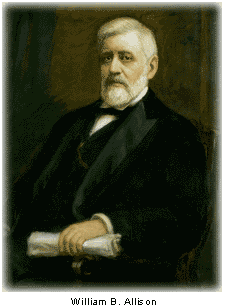Bland-Allison Act
In 1873, Congress had de-monetized silver, thus tying the nation's monetary system firmly to the gold standard. The Bland-Allison Act was labeled the "Crime of '73" by western mining interests and debtors who wanted silver in circulation. A further conservative victory was achieved in 1875 in the passage of the Specie Resumption Act, which was designed to make all currency in circulation, including the greenbacks, backed by gold.
The country was suffering from a depression that followed the Panic of 1873. Debtor elements barraged Congress with requests for assistance. In particular, requests were made for the reinstatement of silver as Legal Tender, a move anticipated to have an inflationary impact.
 Richards P. Bland, a Congressman from Missouri, was able to gain passage of a bill that provided for liberal coinage of silver. The more conservative Senate toned down the House proposal and with the support of Senator William B. Allison of Iowa agreed on the terms of what became the Bland-Allison Act:
Richards P. Bland, a Congressman from Missouri, was able to gain passage of a bill that provided for liberal coinage of silver. The more conservative Senate toned down the House proposal and with the support of Senator William B. Allison of Iowa agreed on the terms of what became the Bland-Allison Act:
- The U.S. Treasury was instructed to purchase between $2 million and $4 million worth of silver each month from the western mines
- The silver was to be purchased at market rates, not at a predetermined ratio pegged to the value of gold
- The metal was to be minted into silver dollars as legal tender.
Reactions to the Bland-Allison Act were predictable. The mining and debtor interests argued that the Bland-Allison did not go far enough and urged the "free and unlimited coinage of silver." The conservative forces took the opposite approach, urged repeal of Bland-Allison and argued that economic sanity could only be restored by adherence to the gold standard.
President Rutherford B. Hayes, influenced by industrial and banking interests, vetoed the measure. Congress promptly overrode the veto.
The Hayes administration blunted the impact of the law by purchasing the minimum amount of silver each month. The result exerted a negligible impact on the economy. As prosperity returned in the early 1880s, passions subsided.
The Bland-Allison Act represented a halting return to bimetallism (gold and silver backing the currency). Gold remained a far greater feature of the monetary picture than silver, so the term "limping bimetallism" has frequently been used to described this program.
 Richards P. Bland, a Congressman from Missouri, was able to gain passage of a bill that provided for liberal coinage of silver. The more conservative Senate toned down the House proposal and with the support of Senator William B. Allison of Iowa agreed on the terms of what became the Bland-Allison Act:
Richards P. Bland, a Congressman from Missouri, was able to gain passage of a bill that provided for liberal coinage of silver. The more conservative Senate toned down the House proposal and with the support of Senator William B. Allison of Iowa agreed on the terms of what became the Bland-Allison Act: